RFID Guide
How does RFID work? Learn how frequency, protocol, and chipset impacts reader compatibility.

Note: The 1024_0B is identical to the 1024_0, except that it comes pre-assembled in a plastic shell enclosure and you have the option of which length of USB cable you want to include.
When an RFID tag comes in close proximity to the PhidgetRFID Read-Write, it reads the tag string so it can be used in your program. Writing custom tag strings to writable tags is also supported.
RFID (Radio Frequency Identification) systems use data strings stored inside RFID tags to uniquely identify people or objects when their tags are scanned by an RFID reader. These types of systems are found in many applications such as passport protection, animal identification, inventory control systems, and secure access control systems.
The PhidgetRFID Read-Write supports reading and writing in 3 protocols: EM4100/EM4102, ISO11785 FDX-B, and PhidgetTag.
The 1024 has two digital outputs, labeled "+5V" and "LED". These work the same as any other Phidgets Inc. digital output, except that the "+5V" output has a higher current rating. You can use these outputs to turn on an LED or activate another circuit when a tag read has occured.
The PhidgetRFID Read-Write is compatible with tags that use either the EM4100 series, ISO11785 FDX-B, or plaintext ASCII protocols. It is compatible with both the read-only and read-write tags sold here. Here's a list of all available tags:
| Product | Tag Properties | |||
|---|---|---|---|---|
| Part Number | Price | Supported Protocols | Tag Characteristics | Typical Read/Write Distance (with 1024 - PhidgetRFID R-W) |
 RFID Tag - Credit Card Sized
|
$1.10 | EM4102 | Passive, Read-Only | 110 mm |
 Writable RFID Tag - PVC Card
|
$1.50 | EM4100, ISO11785 FDX-B, ASCII | Passive, Read/Write | 120 mm |
 RFID Tag - Watch with Adjustable Strap
|
$2.75 | EM4102 | Passive, Read-Only | 80 mm |
 RFID Tag - Watch-like with Elastic Strap
|
$2.00 | EM4102 | Passive, Read-Only | 80 mm |
 Writable RFID Tag - Watch with Adjustable Strap
|
$3.00 | EM4100, ISO11785 FDX-B, ASCII | Passive, Read/Write | 100 mm |
 RFID Tag - ABS Key Fob Blue
|
$1.30 | EM4102 | Passive, Read-Only | 80 mm |
 RFID Tag - Bird Leg Ring Black
|
$0.80 | EM4102 | Passive, Read-Only | 50 mm |
 RFID Tag - Blue Key Fob
|
$1.30 | EM4102 | Passive, Read-Only | 80 mm |
 Writable RFID Tag - ABS Key Fob
|
$1.20 | EM4100, ISO11785 FDX-B, ASCII | Passive, Read/Write | 100 mm |
 RFID Tag - 18mm PVC Disc
|
$1.00 | EM4102 | Passive, Read-Only | 50 mm |
 RFID Tag - 30mm Disc Black
|
$1.30 | EM4102 | Passive, Read-Only | 100 mm |
 RFID Tag - 5cm Metal Mount
|
$2.50 | EM4102 | Passive, Read-Only | 80 mm |
 RFID Tag - Clothing Button
|
$2.00 | EM4102 | Passive, Read-Only | 60 mm |
 RFID Tag - PVC 30mm Disc White
|
$1.00 | EM4102 | Passive, Read-Only | 80 mm |
 RFID Tag - Threaded Black
|
$0.80 | EM4102 | Passive, Read-Only | 70 mm |
 Writable RFID Tag - ABS Disc 30mm
|
$2.30 | EM4100, ISO11785 FDX-B, ASCII | Passive, Read/Write | 100 mm |
 Writable RFID Tag - PVC Disc 25mm
|
$1.50 | EM4100, ISO11785 FDX-B, ASCII | Passive, Read/Write | 100 mm |
 Writable RFID Tag - PVC Disc 30mm
|
$1.50 | EM4100, ISO11785 FDX-B, ASCII | Passive, Read/Write | 100 mm |
Use a USB cable to connect this Phidget to your computer. We have a number of different lengths available, although the maximum length of a USB cable is 5 meters due to limitations in the timing protocol. For longer distances, we recommend that you use a Single Board Computer to control the Phidget remotely.
| Product | Physical Properties | |||
|---|---|---|---|---|
| Part Number | Price | Connector A | Connector B | Cable Length |
 USB-A to Mini-B Cable 28cm 24AWG
|
$3.00 | USB Type A | USB Mini-B | 280 mm |
 USB-A to Mini-B Cable 28cm Right Angle
|
$3.50 | USB Type A | USB Mini-B (90 degree) | 280 mm |
 USB-A to Mini-B Cable 60cm 24AWG
|
$3.50 | USB Type A | USB Mini-B | 600 mm |
 USB-C to Mini-B Cable 60cm 28AWG
|
$5.00 | USB Type C | USB Mini-B | 600 mm |
 USB-A to Mini-B Cable 83cm Right Angle
|
$4.50 | USB Type A | USB Mini-B (90 degree) | 830 mm |
 USB-A to Mini-B Cable 120cm 24AWG
|
$4.00 | USB Type A | USB Mini-B | 1.2 m |
 USB-A to Mini-B Cable 180cm 24AWG
|
$4.00 | USB Type A | USB Mini-B | 1.8 m |
 USB-C to Mini-B Cable 180cm 28AWG
|
$6.00 | USB Type C | USB Mini-B | 1.8 m |
 USB-A to Mini-B Cable 450cm 20AWG
|
$12.00 | USB Type A | USB Mini-B | 4.5 m |
The PhidgetRFID reads data from RFID tags that transmit in the 125kHz range and use a supported protocol. When the tag is brought near the surface of the PhidgetRFID, if the antenna is enabled it will inductively power the tag, which will transmit its data.
If you have a writable tag, you can also use the PhidgetRFID to write custom data to the tag. The tag data must conform to the protocol's format. See the Advanced Topics section below for more details.
You can use your Control Panel to explore your Phidget's channels.
1. Open your Control Panel, and you will find the following channels:
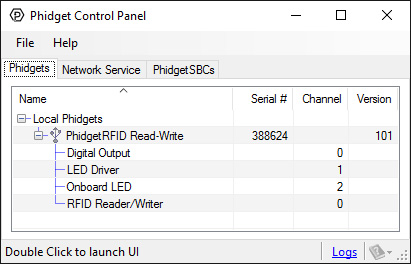
2. Double click on a channel to open an example program. Each channel belongs to the Voltage Ratio Input channel class:
In your Control Panel, double click on "Digital Output":

In your Control Panel, double click on "LED Driver":

In your Control Panel, double click on "Onboard LED":
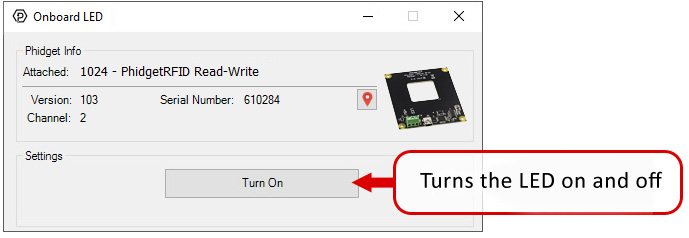
In your Control Panel, double click on "RFID Reader/Writer":

1. Setting up your Programming Environment
Before you open a Phidget channel in your program, you can set these properties to specify which channel to open. You can find this information through the Control Panel.
1. Open the Control Panel and double-click on the red map pin icon:

2. The Addressing Information window will open. Here you will find all the information you need to address your Phidget in your program.

See the Phidget22 API for your language to determine exact syntax for each property.
Firmware Upgrade
MacOS users can upgrade device firmware by double-clicking the device row in the Phidget Control Panel.
Linux users can upgrade via the phidget22admin tool (see included readme for instructions).
Windows users can upgrade the firmware for this device using the Phidget Control Panel as shown below.
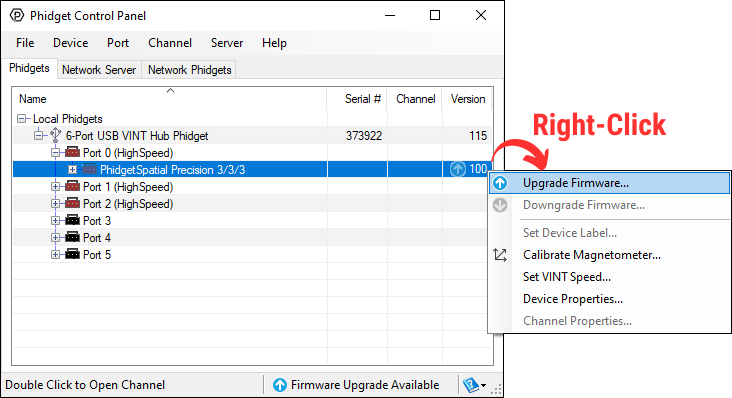
Firmware Downgrade
Firmware upgrades include important bug fixes and performance improvements, but there are some situations where you may want to revert to an old version of the firmware (for instance, when an application you're using is compiled using an older version of phidget22 that doesn't recognize the new firmware).
MacOS and Linux users can downgrade using the phidget22admin tool in the terminal (see included readme for instructions).
Windows users can downgrade directly from the Phidget Control Panel if they have driver version 1.9.20220112 or newer:
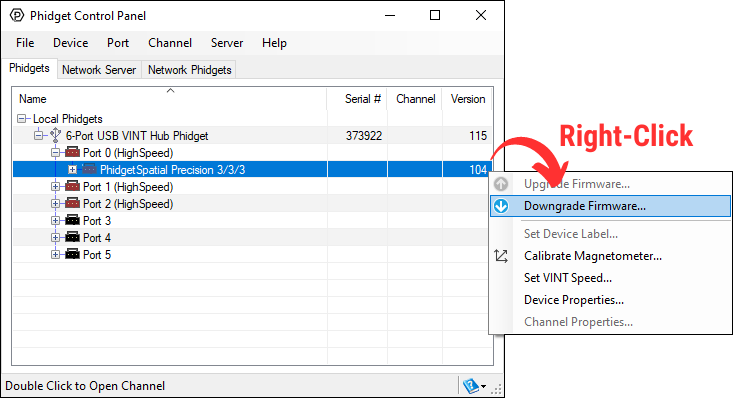
Firmware Version Numbering Schema
Phidgets device firmware is represented by a 3-digit number. For firmware patch notes, see the device history section on the Specifications tab on your device's product page.
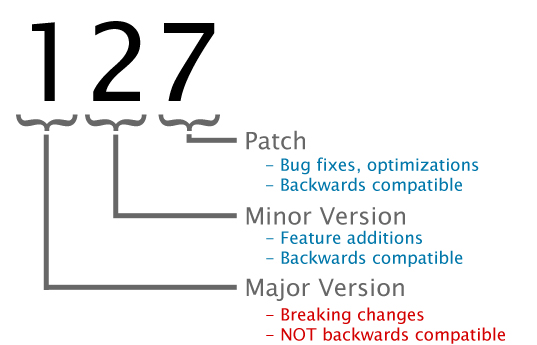
A protocol is a way of encoding data on an RFID tag. We support three reading and writing protocols with the 1024:
EM4100 (also known as EM4102) is the protocol that all previous PhidgetRFID readers have supported. Therefore, if you want to use the 1024 to write to writable tags to be read with previous versions of the PhidgetRFID, you need to write them in this protocol first. This protocol encodes 40 bits of arbitrary data. Read-only tags that are factory programmed with this protocol are supposed to be unique.
Phidgets represents this protocol as a 10-digit hex string, include leading 0's (e.g. 0087f3bc91). This is the format to use for writing new tags, and to expect from the tag events.
ISO11785 defines tags used for animal IDs. If you have a pet cat or dog, chances are high that they have one of these tags implanted. FDX-B refers to the way that the ISO11785 data is encoded on the RFID tag, and is the industry-standard encoding scheme.
This tag consists of a 10-bit country code and a 38-bit unique ID.
The country code is ISO 3166. The '999' code is set aside for testing.
The unique ID is 38-bit unsigned, so that's a range of 0 - 274,877,906,943.
Phidgets represents this protocol as a 15-digit decimal number string - concatenated 3-digit country code and 12-digit id. For example, 999000000000123 would represent the testing country code and an id of 123. Please note that the 12-digit id part cannot exceed the 38-bit maximum integer value of 274,877,906,943.
Note that Animal tags with a valid country code are supposed to be unique. Of course, with the 1024 you can freely copy an existing Animal Tag.
The PhidgetsTAG protocol is an internal protocol only supported by the PhidgetRFID 1024.
This protocol allows storing an ASCII string, up to 24 characters (e.g. I am a Phidgets Tag!)
The ASCII data must be 7-bit, so no extended ASCII support, but standard text is all supported (as well as control codes).
If you are using multiple RFID readers, placing them too close together will cause interference when reading tags. You could work around this problem by rapidly "polling" each 1024 by turning the antenna on, checking for tags, and then turning it off in sequence. Of course, this will lengthen the amount of time it takes for your system to read a tag, since you may have to wait for the nearest reader to become active.

|
Phidgets Inc |
| 1024_0 | |
| FCC ID: SUT1024-0 |
When trying to read tags, you should allow the tag to remain within detection range for at least 50ms. Tags moving through the detection area faster than this may not register at all.
For more information on RFID readers and tags, visit the RFID Guide.
| Board Properties | |
|---|---|
| Controlled By | USB (Mini-USB) |
| API Object Name | RFID |
| USB Speed | Full Speed |
| RFID Reader | |
| API Object Name | RFID |
| Antenna Resonant Frequency Min | 125 kHz |
| Antenna Resonant Frequency Max | 150 kHz |
| Supported Protocols | EM4100, ISO11785 FDX-B, PhidgetTag |
| USB Speed | Full Speed |
| Electrical Properties | |
| Available External Voltage (+5V) | 5 V DC |
| Available External Voltage (LED) | 5 V DC |
| Available External Current (+5V) | 400 mA |
| Available External Current (LED) | 16 mA |
| Output Impedance (LED) | 250 Ω |
| Current Consumption Min | 27 mA |
| Current Consumption Max | 150 mA |
| Physical Properties | |
| Recommended Wire Size | 16 - 26 AWG |
| Operating Temperature Min | 0 °C |
| Operating Temperature Max | 70 °C |
| Digital Outputs | |
| Number of Digital Outputs | 2 |
| Digital Output Voltage Min | 0 V DC |
| Digital Output Voltage Max | 5 V DC |
| Customs Information | |
| Canadian HS Export Code | 8471.80.00 |
| American HTS Import Code | 8471.80.40.00 |
| Country of Origin | CN (China) |
| Date | Board Revision | Device Version | Packaging Revision | Comment |
|---|---|---|---|---|
| February 2013 | 0 | 100 | Product Release | |
| October 2015 | 0 | 101 | OS X El Capitan USB bug fix | |
| September 2017 | 0 | 101 | B | Added plastic shell enclosure and removed USB cable |
| May 2018 | 0 | 103 | B | Fixed offboard LED blip and changed default to OFF |
| Channel Name | API | Channel |
|---|---|---|
| RFID Reader/Writer | RFID | 0 |
| Digital Output | DigitalOutput | 0 |
| LED Driver | DigitalOutput | 1 |
| Onboard LED | DigitalOutput | 2 |
| API | Detail | Language | OS | |
|---|---|---|---|---|
| RFID | Visual Studio GUI | C# | Windows | Download |
| RFID | JavaScript | Browser | Download | |
| RFID | Objective-C | macOS | Download | |
| RFID | Swift | macOS | Download | |
| RFID | Swift | iOS | Download | |
| RFID | Visual Basic .NET | Windows | Download | |
| RFID | Max/MSP | Multiple | Download | |
| DigitalOutput | Visual Studio GUI | C# | Windows | Download |
| DigitalOutput | JavaScript | Browser | Download | |
| DigitalOutput | Multi-Channel Example | JavaScript | Browser | Download |
| DigitalOutput | Objective-C | macOS | Download | |
| DigitalOutput | Swift | macOS | Download | |
| DigitalOutput | Swift | iOS | Download | |
| DigitalOutput | Visual Basic .NET | Windows | Download | |
| DigitalOutput | Max/MSP | Multiple | Download |